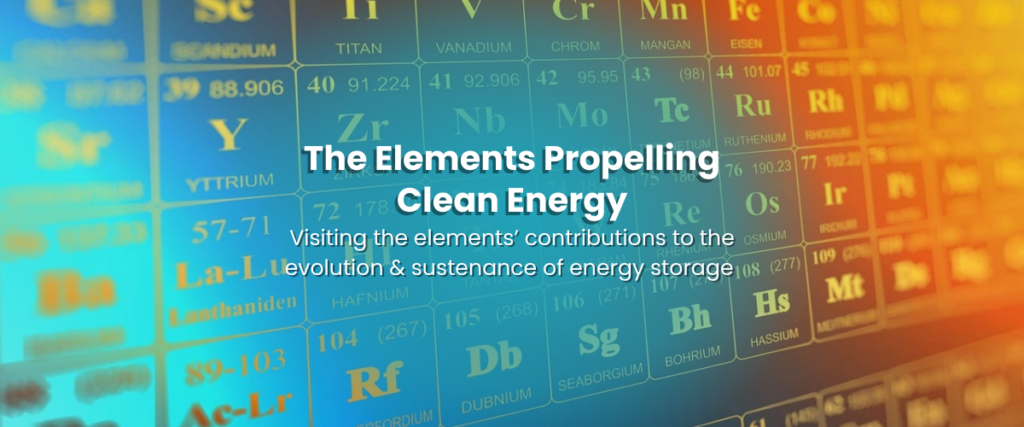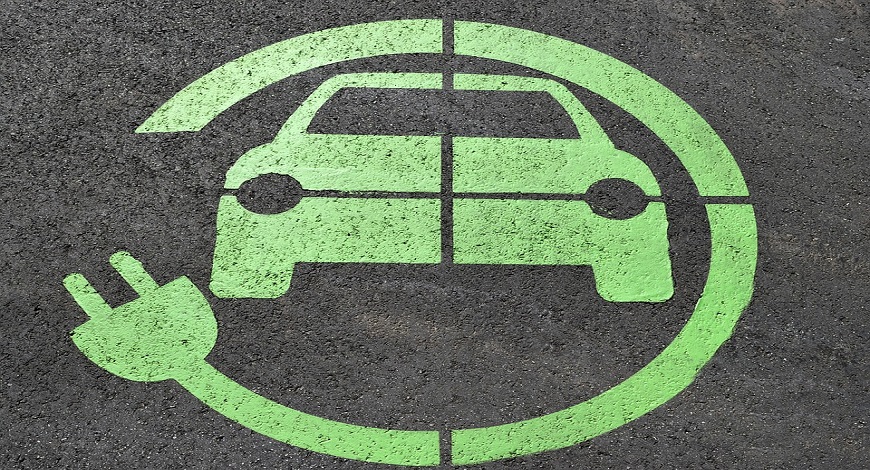
In lithium-ion batteries, an intricate arrangement of elements helps power the landscape of sustainable energy storage, and by extension, the clean energy transition. This edition of the LOHUM Green Gazette delves into the specifics of each mineral, visiting their unique contributions to the evolution and sustenance of energy storage. While Lithium is the predominant element in Li-ion batteries, it is also highly volatile and reactive, as well as costly. Thus, innovators have also been figuring out how to reduce the quantity of Lithium used inside a battery with other, less reactive battery material while retaining maximum functionality.
Previously, we covered contemporary Lithium Battery technologies and the roles they play across various electronics, which are primarily made up of Lithium, Nickel, Cobalt, Graphite, or Manganese-containing battery material.
This listicle covers those lithium battery elements, as well as a few others that serve auxiliary roles within batteries aside from the Cathode and Anode.
Graphite takes center stage as the primary battery material for anodes, offering abundant supply, low cost, and lengthy cycle life. Its efficiency in particle packing enhances overall conductivity, making it an essential element for efficient and durable lithium ion batteries.
Aluminum, while not typically used as an anode material, is a key player in lithium-ion batteries. It serves as the current collector in the cathode and for other parts of the battery. Aluminum still emerges as a promising anode candidate as seen in NCA batteries, balancing low cost, high capacity, and favorable equilibrium potential for lithiation/delithiation. Despite its potential, challenges like the formation of a compact surface oxide layer and volume changes pose hurdles to its widespread application as an anode.
Nickel assumes a key role in the cathodes of nickel-manganese-cobalt lithium-ion batteries and is highly prized in the electric vehicle revolution. Its attributes, including high energy density, a long cycle life, and rapid charging capabilities, position it as a key element in the journey toward sustainable transportation.
Copper, while not a battery material that serves as a cathode or anode itself, is valued for its excellent electrical conductivity and serves as the current collector for both anode and cathode electrodes in lithium-ion batteries. Copper is used for several critical components in lithium-ion batteries due to its excellent electrical conductivity, chemical stability, and cost-effectiveness.
While not a core component, steel plays a pivotal role in constructing battery casings and other structural elements. Its inclusion ensures the stability and durability of lithium-ion batteries, providing the necessary structural support for long-term functionality
Manganese’s stabilizing role in the cathodes of nickel-manganese-cobalt (NMC) batteries contributes not only to stability but also to increased energy density. This dual function enhances the driving range of electric vehicles, making manganese a vital strategic element for battery technology. In recent years, Manganese has seen an uptick in demand thanks to its viability and cost-effectiveness.
Cobalt emerged as a key player in boosting energy density and maintaining the stability of the cathode’s layered structure. Its role in preventing structural degradation during charging and discharging cycles ensures the prolonged life of lithium-ion batteries. However, Cobalt production has been shrouded in unsustainable and harmful mining activities, which is why manufacturers are increasingly turning to recycled cobalt, which dampens the demand for mining.
Alternatively, innovators are seeking ways to reduce cobalt use altogether. Recycled cobalt or cobalt of the secondary materials ecosystem is produced at LOHUM from used EV batteries, with industry-leading recovery rates and purity levels.
Lithium, powering the migration of ions between the cathode and anode, stands as the key dynamic force behind the battery power of today. Its unique properties make it indispensable for the functioning of lithium-ion batteries, driving the devices that define our modern world. Pure Lithium metal has a wide variety of use cases ranging from EV batteries, Consumer Electronics batteries, Aerospace, advanced metallurgy, medical and industrial compounds, and is a key requirement for manufacturing the Lithium Air battery, featuring a Lithium anode.
LOHUM recently became the first company outside of China to produce pure metallic Lithium, and the first in the world to produce it through battery recycling. This is a paradigm-shifting breakthrough, as Pure Lithium is the key prerequisite for Lithium-air batteries, which are considered the holy grail of all EV battery technologies, as a Lithium-air battery the size of a small backpack can power an EV for around 1000 Kilometers on a single charge.
While not a common component in lithium-ion batteries, gold’s high conductivity and resistance to tarnishing make it a valuable element in high-grade electronics. Its reliability ensures seamless operation and has diverse applications in all kinds of technology hardware. Gold is found in higher-end smartphones, laptops, vehicular electronics, etc, and may also be found in BMS circuit boards or various connector points.
Iron’s role in lithium iron phosphate batteries extends beyond stability. As a cathode material, it ensures good electrochemical properties and a stable structure during charging and discharging processes, contributing to reliable battery performance. Iron is why LFP batteries took off first in the market, why they are considered the baseline today, and likely will keep serving energy for decades to come.
Various insights featured on Mckinsey shed light on ongoing changes, ideal electric vehicle ranges, and the significance of battery chemistries like NMC 811 and NCA. Market dynamics influenced by raw material availability and vertical integration trends among OEMs shape the trajectory of the battery industry. The industry’s commitment to innovation is evident in advancements like solid-state batteries and the paradigm shift toward lithium anodes through the Lithium-Air battery. The focus on high-manganese asphalt batteries signifies a continuous push for enhanced technology, paving the way for a more sustainable future.
Battery chemistries like NMC 811 and NCA play a significant role in this landscape. These chemistries are increasingly popular in commercial lithium-ion batteries (LIBs) used in electric vehicles and planes. The market dynamics are also influenced by vertical integration trends among Original Equipment Manufacturers (OEMs). Automotive OEMs are increasingly involved in converter manufacturing, and moving towards manufacturing power modules. This trend towards vertical integration is driven by the need for supply certainty and the desire for exposure to higher value-added products.
The battery industry’s commitment to innovation is evident in advancements like solid-state batteries and the paradigm shift towards lithium anodes. Solid-state batteries replace the liquid electrolyte in lithium-ion batteries with ceramics or other solid materials. This swap unlocks possibilities that pack more energy into a smaller space, potentially improving the range of electric vehicles. Solid-state batteries could also move charge around faster, meaning shorter charging times and higher voltages. Lithium metal anodes can significantly increase the energy density of batteries, making them more efficient. The focus on high-manganese asphalt batteries signifies a continuous push for enhanced technology through all combos of elements. Manganese, being a plentiful metal, could make batteries and EVs affordable enough for a wider audience of mainstream buyers.
From the intricacies of these minerals powering the lithium ion battery revolution, their collective impact on the energy transition ecosystem and their role as battery raw material become apparent. These minerals are not just components but catalysts propelling us toward a future where clean, efficient, and sustainable energy is not a choice but an existential necessity. The production of lithium-ion batteries comes with a significant CO2e and GHG impact, with about 40 percent of it coming from the mining and processing of the minerals needed.
However, the transition to electric vehicles and renewable power is expected to significantly increase the demand for these minerals. Therefore, it is crucial to ensure that the mining and processing of these minerals are done sustainably to minimize their environmental impact, and that battery recycling is effectively leveraged to build a sustainable secondary materials ecosystem. As we continue to innovate and push the boundaries of technology, these minerals will continue to play a crucial role in shaping our sustainable and energy-abundant future.
Keep up with LOHUM’s series on the energy transition economy: #GreenGazette, and our LinkedIn page for more insightful content on sustainability, battery energy, energy transition, circular economy, battery recycling, and more!
Related blogs
This entrepreneur wants India to make its own lithium-ion cells for electric vehicle batteries

Forbes India
Rajat Verma already recovers raw materials from used cells at his venture, LOHUM Cleantech. He wants to close the loop by making cells in India as well.
India needs integrated recycling and repurposing battery business model: Rajat Verma of LOHUM Cleantech

YOURSTORY
In an interaction with AutoStory, Rajat Verma, Founder and CEO of LOHUM Cleantech, speaks about building his company, and about battery manufacturing and repurposing as an industry.
Sourcing Raw Materials Is A Big Challenge In Li-ion Battery Space: Founder Lohum

Business World Disrupt
Recognized as ‘The Most Innovative Company of the year 2022’ by The Confederation of Indian Industry (CII), LOHUM is a producer of sustainable Li-ion battery raw materials
1800 572 8822
Email : enquiry@lohum.com
G98, Site, 5, Kasna, Block A, Surajpur Site V, Greater Noida, Uttar Pradesh 201306
LOHUM Cleantech Private Limited, Plot No. D-7 & 8, Site 5th, Kasna Industrial Area, Greater Noida, Gautam Budh Nagar, Uttar Pradesh – 201308
LOHUM Cleantech Private Limited, Plot No. O-17, Site 5th, Kasna Industrial Area, Greater Noida, Gautam Budh Nagar, Uttar Pradesh – 201308